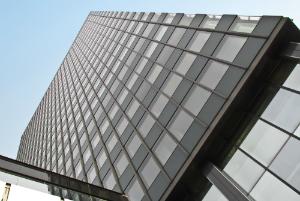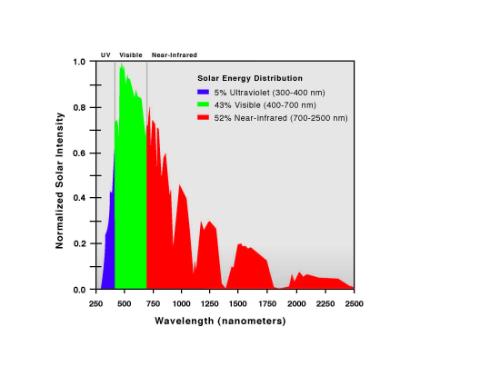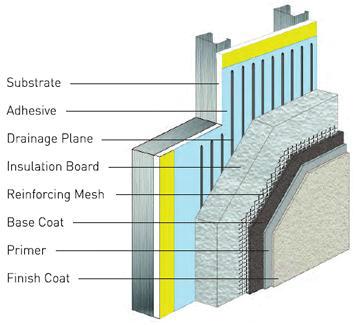 Some guidelines to keep in mind to keep dark-colored buildings cool. In this aspect, dyes that reflect sunlight make a difference.
Some guidelines to keep in mind to keep dark-colored buildings cool. In this aspect, dyes that reflect sunlight make a difference.
by CPS Color*
Heat buildup doesn't just affect people who wear dark colors. The same goes for painted surfaces, such as walls, frames and facades. Even so, architects, builders or owners do not want to limit themselves to white or pastel colors to decorate a building. Recent trends and tastes have raised the demand for dark colors for facades.
New dyes with reflectance from sunlight are a response to this demand: these dyes are beneficial for both materials and users, by reducing, for example, indoor temperature, energy costs and thermal stress. The clever combination of conventional façade dyes with excellent thermal reflectance properties from the sun make it possible to keep dark facades cool.
Solar reflectance coatings are designed to reflect a significant portion of solar radiation from colored surfaces, in order to keep them cool. Heat buildup is minimized without limiting the currently available color options. This can represent an advantage in architectural and decorative painting applications such as ceilings, facades, EIFS systems and window frames. Coatings with solar reflectance help reduce thermal stress in building materials and contribute to better durability of those materials that are very sensitive to temperature.
They can also help reduce electricity costs, as lower demand for air conditioning is achieved in hot climates. Some national regulations already require the application of surfaces with solar reflectance, in order to protect the environment and restrict the so-called urban heat island effect.
Figure 1: Typical spectrum of solar radiation

Maximization of total solar reflectance
The goal of coatings is to maximize the solar reflectance of the coated surface. This is achieved by physical backspapertion of solar radiation by pigment particles. This is a well-known fact in the visible spectrum range, where scattering in the pigment spectrum determines the appearance of their color. However, solar radiation is not only composed of visible "light", but also of ultraviolet (UV) and near-infrared (NIR) light, which dominates the global solar energy radiated by more than 50%.
The amount of total solar energy absorbed by the top layer determines the accumulation of heat from a coated surface. The surface temperature depends largely on the duration of exposure. To achieve cool surfaces, the pigments in the coating have to reflect as much energy as possible. This reflection capacity is expressed in the total solar reflectance (TSR) value, with 100% total reflection and zero total absorption.
Pigments with high TSR values show high reflection, along with low heat accumulation, and vice versa. Traditional white coatings exhibit a total solar reflectance of 75% or more, which, by definition, will absorb 25% of the incident energy. A carbon-black pigment-based coating can have a TSR of as little as 4% and will therefore absorb 96% of the incident solar energy. The pigments with the highest reflectivity are those based on white TiO2, while the pigments with the lowest reflection are those based on carbon black (PBk.7).
LRV vs. TSR in outdoor thermal insulation systems
Architects have seemingly endless options when it comes to facades of commercial buildings and residences. Not only are there many materials available with different colors and textures, but there are also a number of environmental and functional properties that need to be taken into account.
Outdoor Thermal Insulation Systems (EIFS) are a popular and very effective way to thermally insulate a building. Insulation systems for multi-layer exterior walls provide superior energy efficiency and allow for much greater flexibility in design, compared to other cladding products. Although similar in appearance, EIFS systems have very different components and installation requirements than conventional stucco.
Figure 2: Typical section of an EIFS application

The luminous reflectance (LRV) value of a color indicates only how much visible light of that color will be reflected. Black has a zero percent LRV and absorbs all light, which means that black surfaces can get very hot. In contrast, white has a 100% LRV and keeps the buildings bright and cool. All other colors are located between these two extremes.
EIFS manufacturers suggest choosing a finish with an LRV of at least 20. Employing an acrylic finish with an LRV of less than 20 could cause damage to the expanded polystyrene insulation plate and cause the color to fade or change, when using darker color finishes.
Figure 3: LRV Scale

The TSR value, on the other hand, takes into consideration the total amount of energy radiated by sunlight, not just in the visible range. Therefore, two objects may be identical in visible color, but possess different reflective characteristics in the near-infrared region. For example, one remains cooler when exposed to sunlight than the other. This can lead to a situation where two colors have identical LCRs, but possess a radically different level of heat accumulation, depending on whether the pigmentation reflects in the near-infrared range or not.
In EIF systems, TSR or thermal reflectance is more important than mere light reflectance. The new advances make it possible to develop dark color formulas with LRV values below 30, using either specially designed pigments that reflect sunlight, or normal inorganic pigments with good TSR properties. Therefore, LRV should not be the only factor to consider when deciding which colors can be used for EIF systems.
Black dyes with near-infrared reflectance
Because the TSR value covers the entire radiation range, between UV light and near-infrared, black pigments have lower TSR values than white pigments. Carbon black (PBk.7), the most commonly used black pigment, has a high absorption of invisible near-infrared radiation. On facades using EIF systems, dyes containing iron oxide black pigments, such as PBk.11 and PBk.33 are in common use, due to their excellent properties of resistance to weather conditions and light exposure.
In March 2012, CPS Color launched the first of a series of near-infrared reflectance dyes, Novapint D-803, which contains a functional iron-chromium oxide pigment with near-infrared reflectance (PBr.29) from BASF.
Because this product is a dye with mono pigmentation, the TSR value is higher, while the intensity of black is lower, compared to carbon black. The dye was developed for factory dyeing of high-quality, water-based façade systems in order to create cool surfaces from roofs to facades. The coating containing the dye with near-infrared reflectance has been shown to have a much lower surface temperature than a similar coating with black pigments, when exposed to the same conditions.
Dark colors, fresh facades
Pigments with near-infrared reflectance of dyes keep objects cooler by maximizing the TSR value. A high TSR value produces lower surface temperatures, which, in turn, has many advantages: cooler surfaces, lower electricity consumption and greater durability of materials, including EIF systems.
And this is exactly what CPS's Novapint D dyes do, which reflect solar radiation. They combine dyes for conventional facades that have excellent solar heat reflectance properties with a functional black dye that reflects the near infrared, to replace iron oxide black.
The dyes have been specially developed for water-based façade paints and plasters and are compatible with synthetic resin, silicone and silicate-based paints and plasters. Simply put, these solar reflectance dyes minimize heat buildup in architectural and decorative paint applications and provide fresh colors for building facades.
Authors: - Bas van Ravenswaaij, global product manager, dyes, CPS Color, Sittard, The Netherlands
- Judith Huijnen, Product Manager, Colorants EMEA, CPS Color, Sittard, The Netherlands
























Leave your comment